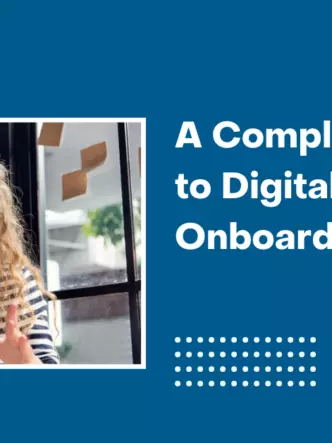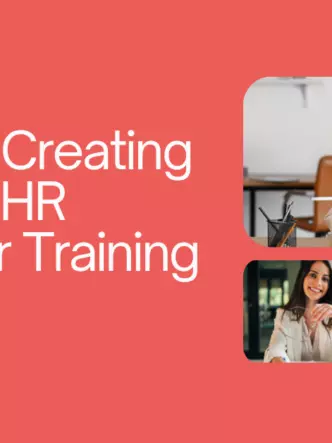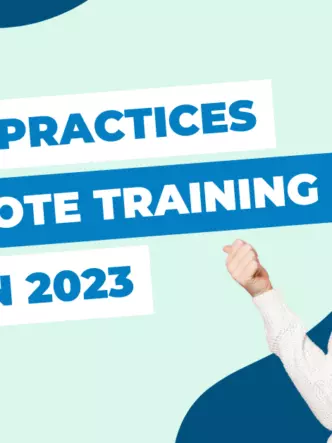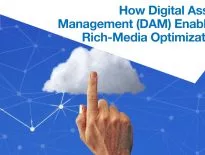
Ask learning and development professionals what their biggest challenge is and they’ll tell you it’s keeping learners engaged.
Considering the deluge of information employees are bombarded with, sending them a text-heavy onboarding manual or professional development training material is sure to get lost in the shuffle.
This is where visual learning can prove to be effective.
According to a research study:
- 58% of employees believe that they remember information longer when it’s visual
- 41% of employees say they learn better with visuals
- Employees absorb information 7% faster when communications are visual
It’s safe to conclude that using visual training materials leads to an increase in engagement and information retention while helping employees grasp concepts with ease.
Let’s take a look at seven visuals that make for effective remote employee training materials.
1. Infographics
A handbook filled with blocks of text versus a visually appealing infographic — which one is likely to capture and retain your attention?
Chances are it’s the latter.
Infographics make for powerful employee training materials because they have the ability to present complex information in a manner that’s easy to grasp and understand.
While creating infographics, make sure you minimize text and support the information with visuals such as illustrations, photos, graphs, icons, and symbols.
Here are the different ways to use infographics in your remote employee training materials:
- Simplify complex concepts
- Summarize information
- Visualize data and statistics
- Make comparisons
- Organize information and aid comprehension
For example, here’s a comparison infographic that illustrates the dos and don’ts by laying them out side-by-side. Notice how it pairs every point with an icon which makes the information memorable.

Source: Venngage
2. Presentation decks
Presentation decks are common employee training and development materials, regardless of whether you’re delivering synchronous or asynchronous training.
But if your slides are monotonous, poorly designed, consist of too much text, and have an endless list of bullet points, then you might be inflicting ‘death by PowerPoint’ on your employees.
If you want to make an impact with presentation decks, you need to make them visual. No, boring stock photos don’t count. Use meaningful visuals that help you deliver your message while adding to the overall aesthetic.
Here are design best practices to consider while creating presentation decks for employee training materials:
- Focus on one key takeaway per slide
- Use visuals to make the information memorable
- Include a variety of slide layouts to keep the audience engaged
- Minimize text on the slides (not more than five lines of text per slide)
- Stick to a color scheme
- Emphasize information with colors, text size, and weight
Take a look at this engaging presentation deck. It combines icons, graphs, and text to present the information effectively and capture the reader’s attention.

Source: Venngage
3. Videos
Microsoft saved $303 per person when they decided to replace their classroom training sessions with videos.
And this is just one of the benefits of including videos in your employee training and development program.
It’s no secret that videos are highly engaging content formats. Not only do they demonstrate concepts and deliver information effectively but they also have the power to improve retention and retain the learner’s attention for a longer period of time.
You can create different types of employee training videos such as:
- Screencasts: to provide a demonstration or step-by-step tutorial
- Explainer videos: to introduce a concept, tool, or process
- Interactive videos: to create an immersive learning experience
- Animated videos: to explain a complex topic
Here’s a good example of an animated video by Reach Out that educates employees about workplace bullying.

4. Charts
Good data makes for great stories and deserves to be part of your employee training content.
But what happens when you fail to present that data effectively? Your training program becomes a data dump.
This is where charts come into the picture. When used properly, they can:
- Improve comprehension of complex concepts
- Reinforce the core message
- Make key insights memorable
- Increase the persuasiveness of claims
Whether you’re sharing business data or presenting industry trends, it’s important to pick the right kind of chart for your data. This will add clarity and prevent misinformation.
The broad objectives of using charts can be divided into:
- Inform (eg. donut chart, pictograph, etc.)
- Compare (eg. bar chart, pie chart, bubble chart, etc.)
- Show change (eg. line chart, area chart, timeline, etc.)
- Organize (eg. table, list, Venn diagram, etc.)
- Reveal relationships (eg. scatter plot, histogram, etc.)
Here’s an example of a bar chart that illustrates the net gains and losses without overwhelming readers. It uses a simple color palette and has clear data labels.

Source: Venngage
5. Checklists
A huge part of employee training is ensuring that employees implement their learnings in their day-to-day work. One way to achieve that is to provide employees with checklists.
Apart from being functional and informative, checklists also help reinstate and summarize large chunks of information. They aid task prioritization and motivate employees to take action.
Here are the different ways to use checklists as part of employee training:
- Employee onboarding
- Safety training
- Performance evaluation
- Employee wellbeing
- Job aids for recurring tasks
Take a look at this job aid checklist example. It uses short sentences to outline the various tasks. The clean background and color-coded categories make it easy to scan and read.

Source: Venngage
6. Roadmaps
As a learning and development professional, your goal is to ensure that your employees get access to the right kind of training that is in line with the company’s objectives.
Enter learning paths.
As stated in the book, Learning Paths, mapping out learning paths reduces training time by 30% or more.
Creating learning paths or roadmaps involves chalking out what your learners need to achieve along with the method of learning and duration. It helps trainers and learners take a more structured approach and makes it easier to track training progress.
Create a personalized learning roadmap for employees that takes into account their individual learning paths and goals. This serves as a reference, improves productivity, and keeps them motivated.
Here is an example of a learning roadmap template you can use. It breaks the timeline into smaller segments and allots specific tasks for each time frame.

Source: Venngage
7. Flowcharts
Let’s say you want to educate employees about a new business process or explain a complex workflow. Instead of communicating it in words alone (and have them forget it), why not create a flowchart?
Flowcharts are a useful way to represent a series of steps and guide the learner to make informed decisions.
The best part about flowcharts is that they serve as effective post-training visual aids. They help employees retain information, solve complex problems on the job, and prevent mistakes.
While designing flow charts, it’s a good idea to include a short introduction for context. You can use colors, icons, and arrows to emphasize information. Make sure you keep the design simple and only include essential information that helps employees follow the instructions with ease.
Here’s a flowchart that can be part of your customer support training program. It shows the multiple paths and clearly communicates the corresponding action that needs to be taken.

Source: Venngage
The takeaway: use visuals to create engaging training materials
There is no way your employee training and development program can generate results if you continue to provide your remote employees with boring training material.
Your focus should be to create training content that’s functional and engaging. Using the right kind of visuals will help you create impactful training material that will aid learning and improve employee performance.









